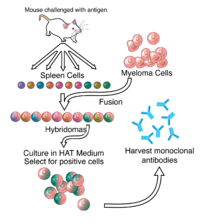
Photo from wikipedia
Background: The SARS-CoV-2 pandemic was particularly devastating for elderly people, and the underlying mechanisms of the disease are still poorly understood. In this study, we investigated fusion inhibitory antibodies (fiAbs)… Click to show full abstract
Background: The SARS-CoV-2 pandemic was particularly devastating for elderly people, and the underlying mechanisms of the disease are still poorly understood. In this study, we investigated fusion inhibitory antibodies (fiAbs) in elderly and younger COVID-19 patients and analyzed predictive factors for their occurrence. Methods: Data and samples were collected in two cohorts of hospitalized patients. A fusion assay of SARS-CoV-2 spike-expressing cells with ACE2-expressing cells was used to quantify fiAbs in the serum of patients. Results: A total of 108 patients (52 elderly (mean age 85 ± 7 years); 56 young (mean age 52 ± 10 years)) were studied. The concentrations of fiAbs were lower in geriatric patients, as evidenced at high serum dilutions (1/512). The association between fiAbs and anti-Spike Ig levels was weak (correlation coefficient < 0.3), but statistically significant. Variables associated with fusion were the delay between the onset of symptoms and testing (HR = −2.69; p < 0.001), clinical frailty scale (HR = 4.71; p = 0.035), and WHO severity score (HR = −6.01, p = 0.048). Conclusions: Elderly patients had lower fiAbs levels after COVID-19 infection. The decreased fiAbs levels were associated with frailty.
Journal Title: Diagnostics
Year Published: 2022
Link to full text (if available)
Share on Social Media: Sign Up to like & get
recommendations!